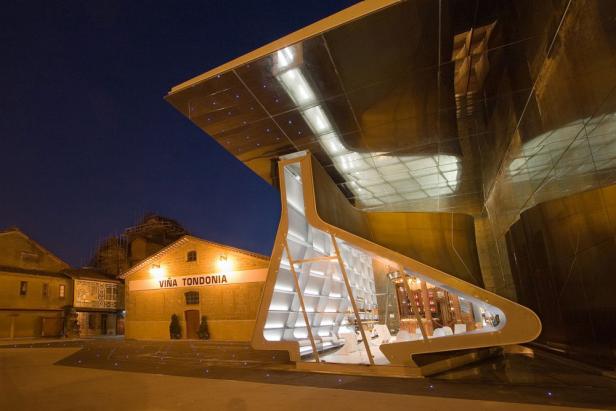
Planning a trip to Spain? Barcelona, Madrid, Seville, Granada and the Balearic Islands are among the top-ranked destinations for most travelers. But there are many other enticing but lesser known regions that are ripe for exploration such as Rioja, Spain.
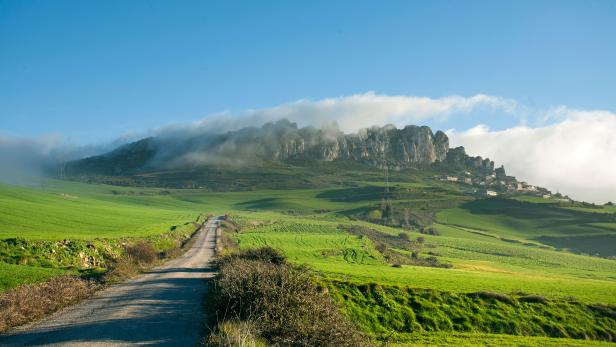
Rioja, Spain
The Rioja region is located in the north-central Spain and is famous for its vineyards and its idyllic countryside with plenty of bike and hiking trails.
Photo by: La Rioja Turismo
La Rioja Turismo
Situated in north-central Spain on the edge of Basque country and just south of Bilbao and the coastal resort town of San Sebastian, Rioja is still a relatively undiscovered but up-and-coming travel destination for those who want to escape the tourist throngs and immerse themselves in the Spanish culture and attractions of a stunningly beautiful agricultural region.
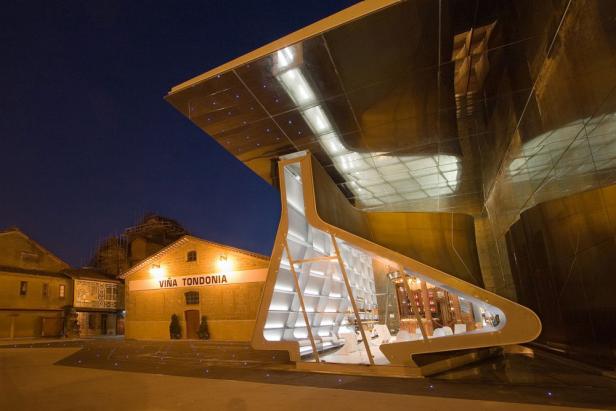
The wine tasting room at Vina Tondonia
The winery R. Lopez de Heredia near Haro, Spain is famous for its unique wine tasting room designed by architect Zaha Hadid.
Photo by: Rioja DOCa
Rioja DOCa
Among the many attributes of Rioja are the unspoiled natural beauty, the historical sites, cultural attractions, recreational activities, the food, and especially the wine, famous for the distinctive, earthy flavors of the Tempranillo grape. Here are just a few of the region’s high points which offer something for everyone.
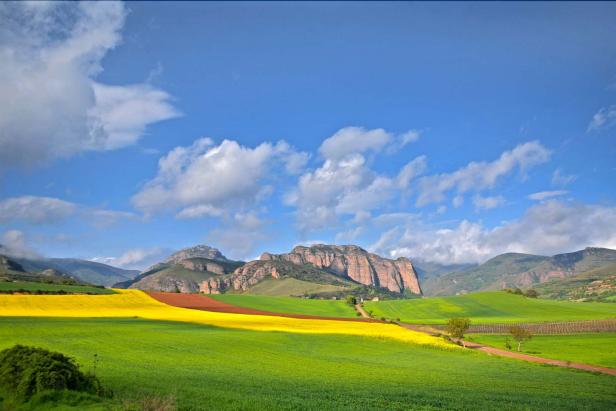
The landscapes of Rioja, Spain
One of the great agricultural and wine-making regions of Spain is Rioja located in the north-central part of the country.
Photo by: La Rioja Turismo
La Rioja Turismo
Countryside Adventures
The Rioja region offers a range of climates and landscapes which includes rolling wheat fields, Medieval villages, the lush green terrain of the Ebro River Valley, the Cantabrian Mountains to the north and the Sierras de Cameros and Demanda ranges to the south, all of which enjoy sunny Mediterranean-like weather. Logrono, the capital of La Rioja, and Haro, the region’s wine hub, are good home bases for planning day excursions into the countryside while providing excellent dining options and local culture at night.
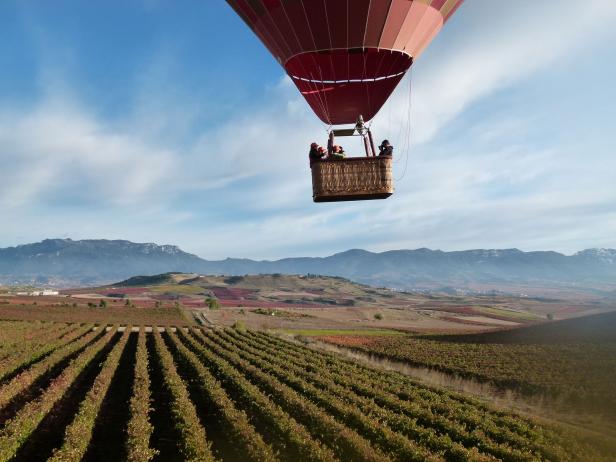
A hot air balloon drifts over the vineyards in Rioja, Spain
A great way to appreciate the wine region of Rioja, Spain is to explore it via a hot air balloon tour.
Photo by: La Rioja Turismo
La Rioja Turismo
You can take a canoe trip down the Ebro River or book a hot air balloon voyage across the vineyards around Haro. Nacedero del Urederra, a national park near the village of Banquedano, is popular with nature hikers and only an hour away by car from Logrono. Or you can create your own walking tour by following the well-traveled pilgrimage route of the Camino de Santiago trail through vineyard country from Logrono to the nearby village of Navarrete.
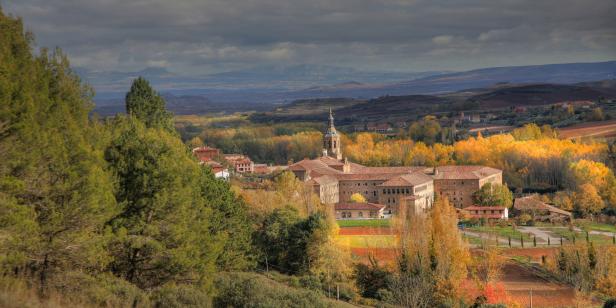
Yuso Monastery
Located in St. Millan, Spain, the 11th century Yuso monastery is famous for its Gothic cloister.
Photo by: La Rioja Turismo
La Rioja Turismo
For the History Buff
There is no shortage of world heritage sites in La Rioja. Davalillo Castle, a 13th century Romanesque fortress overlooking the River Ebro, is worth a visit. The monastic community of St. Millan hosts two UNESCO sites, the 6th century monastery of Suso, which is carved into a mountainside and accessible by shuttle from the town, and the 11th century monastery of Yuso with its monumental Gothic cloister. Visiting the walled city of Santo Domingo de Calzada and getting lost in its labyrinth of ancient streets is like taking a time machine into the past. In fact, historic ruins and landmarks are a predominant aspect of the rural landscapes and countryside and include such sights as the medieval bridge on the road to Briones or the 12th century church of Santa Maria De La Piscina near the village of San Vicente de Sonsierra.
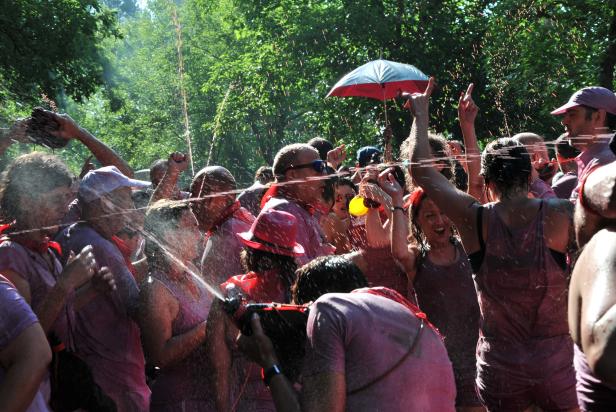
Battle of Wine in Haro, Spain
Every June marks the annual Batalla Del Vino in Haro, Spain where countless partygoers drench themselves in gallons of red wine.
Photo by: La Rioja Turismo
La Rioja Turismo
Cultural Immersion
The best way to meet the locals and immerse yourself in the local culture is to attend one of the many annual festivals in the region such as La Rioja International Plectrum Music Festival (devoted to musicians and ensembles performing string instruments) in Logrono and the Bread and Cheese Festival in Quel, which dates back to 1479 and combines religious pageantry with live music, dancing and food. Of course, some of the biggest events revolve around the local winemakers and vineyards. Batalla Del Vino (Battle of Wine), held in Haro in late June, is a wild street party that lasts almost three days with participants emptying buckets of wine over each other in celebration of St. Peter’s Feast Day.
A similar event, the Battle of Claret, is held in late July in San Asensio and partygoers from Spain and abroad descend on the town to be sprayed with more than 30,000 liters of claret wine. For those who prefer a less rowdy experience, Centro Thematic del Vino Villa Lucia is a well appointed wine museum near Laguardia that is notable for its exotic botanical garden.
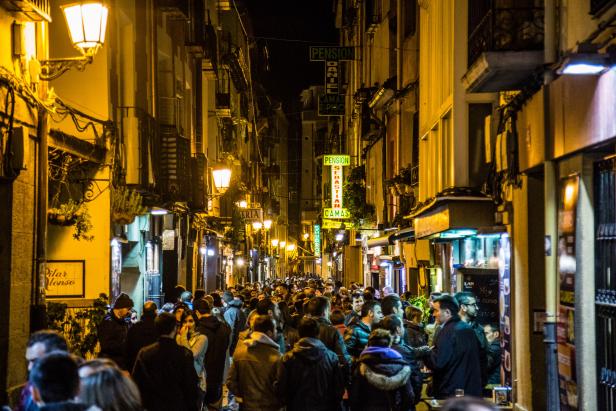
Calle Laurel in Logrono, Spain
Nighttime is the right time to enjoy a tapas crawl along the more than 50 bars and cafes that line this popular food destination in Logrono, Spain in the Rioja region.
Photo by: La Rioja Turismo
La Rioja Turismo
The Dining Experience
Most foodies associate tapas with Spain but La Rioja has their own take on these small plate delights that they call pinchos. Grilled mushrooms with shrimp in garlic sauce, anchovies and green peppers and fried artichokes with ham are examples of the many variations you can sample on Calle Laurel in Logrono. You could do a pinchos crawl choosing from the more than 50 bars/cafes and have a memorable but inexpensive meal with the tapas averaging about $2 each. For a more traditional dining experience, you might try Terete in Haro which has been in business for over 125 years and was a favorite haunt of Ernest Hemingway for its oven-roasted lamb and wine list. Another popular choice is Bodega la Petra which offers fresh vegetarian cuisine and grilled meats in a series of cave rooms burrowed into the gorges around the village of Arnedillo. Serious gourmets will want to experience the suckling pig with orange and vanilla sauce, a house specialty at Los Cubanas in Logrono.
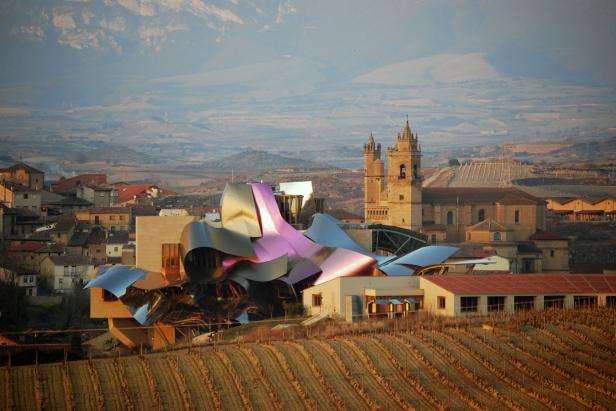
Hotel Marques de Riscal
Photo by: Rioja DOCa
Rioja DOCa
Vineyard Heaven
Wine lovers will be faced with a bewildering choice of wineries (bodegas) to choose from in this region because there are more than 500 of them. One of the most spectacular—Marques de Riscal—is located near the sleepy village of Elciego and includes a stunning hotel on the estate designed by architect Frank Gehry that is quite unique for its silver, pink and gold titanium structure (above photo). Equally awe-inspiring is Bodegas Ysios at the foot of the Sierra de Cantabria mountains near Laguardia with its rippling, wave-like design that blends beautifully into the surrounding landscape; it was designed by world-renowned Valencia-born architect Santiago Calatrava (shown below). You also should check out R. Lopez de Heredia Vina Tondonia near Haro with its amazing underground maze of hundred-year old wine cellars and the sleek futuristic tasting room designed by Zaha Hadid and nicknamed “The Flash.” Most bodegas require reservations in advance of your visit as they can only accommodate small groups so make your bookings prior to arriving in Spain. For more information on Rioja wines, visit La Rioha Denominacion de Origen Calificada (DOCa).
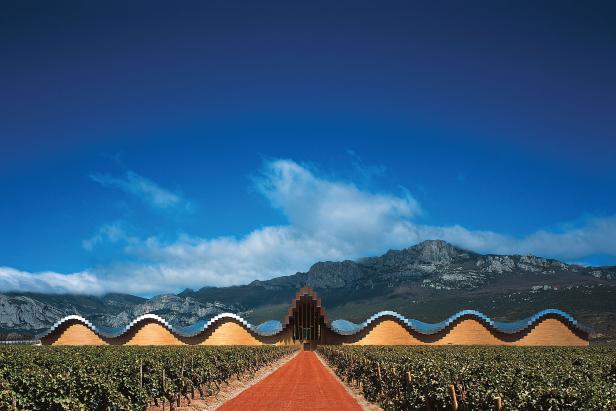
Bodegas Ysios
Located near Laguardia, Spain is the famous Bodegas Ysios with a sleek, modern design by architect Santiago Calatrava.
Photo by: Rioja DOCa
Rioja DOCa
